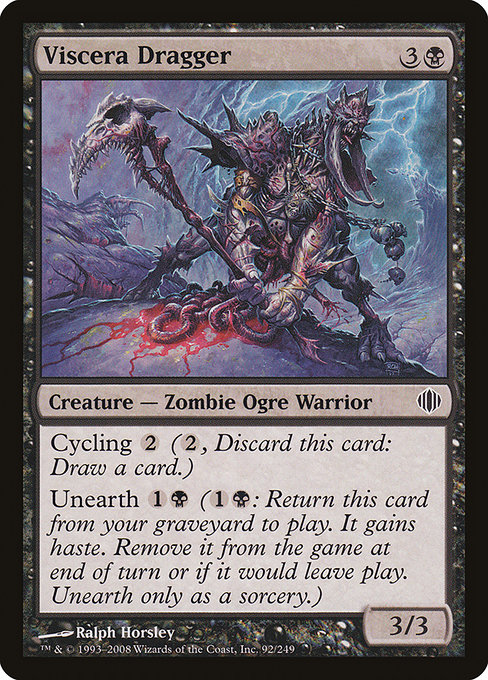
Image courtesy of Scryfall.com
Meta-Aware MTG Design in Action: A Case Study with Viscera Dragger
Magic: The Gathering has always thrived on a balance between power, flexibility, and a little bit of mystery. As the game ages, designers increasingly embrace a forward-looking philosophy: create cards that feel purposeful today while still aging gracefully with the meta of tomorrow 🧙♂️🔥. A standout example from the Shards of Alara era—Viscera Dragger—offers a compact blueprint for how meta-aware design can live on in both casual kitchens and competitive back rooms. This black-aligned creature, a Creature — Zombie Ogre Warrior with a modest six-mana plan on the horizon, signals a bold truth: value can be layered, not just slammed onto a card at print time 💎⚔️.
Viscera Dragger is a rare instance of a common-level card that wears two separate utility belts at once. With a base body of 3/3 for 4 mana, it fits Black’s classic attrition posture: a sturdy beater that can still trade up with the right support. But its true design genius lies in its engine: Cycling {2} and Unearth {1}{B}. The Cycling ability gives you a built-in option to dig for what you need when the game drags on, turning a potential brick into a flexible drawing engine. The Unearth ability, meanwhile, unlocks a dangerous late-game threat—bring the 3/3 back from the graveyard with haste, only to exile it at the start of the next end step or when it leaves the battlefield. That creates a tempo playbook where you can pressure, retreat, and re-enter the battlefield with a second wind 💥🎲.
Designers live for moments when a single card can wear multiple identities depending on how the game unfolds. Visceral in concept and clean in execution, Viscera Dragger embodies what meta-aware design can look like when a card balances early-game inevitability with late-game recursiveness. The fact that it’s a common in a 2008 expansion set—Shards of Alara, a set famous for its shard-themed, color-constrained design—also says something about the long arc of card utility. Even a common can underpin a deck’s plan long after its first rotations, especially in formats that reward graveyard interaction and resilient bodies. And let’s be honest: the black color identity has always thrived on reanimation rhythms, and this card captures that vibe in a surprisingly elegant package 🧙♂️💎.
“Design for the long game: give players choices, and let the metagame prove the worth of those choices over time.”
In practical terms, Viscera Dragger nudges players toward a few core strategies that have staying power in modern MTG design thinking. First, it rewards graveyard fluidity. While Unearth is a straightforward recursion tool, its real power is that it can enable replays of pressure in a tempo-driven game plan, especially when the graveyard becomes a resource. Second, Cycling acts as a safety valve—if you draw this card early, you can pay two to discard and draw a fresh card, keeping the deck’s flow healthy in grindy matches. Third, the combination of a 3/3 body with a flexible path back from the graveyard provides a tool that scales with the game’s tempo, letting players decide whether to push damage or reconfigure the battlefield on the next turn 💥🎨.
From the perspective of a designer, the lesson is clear: the next wave of meta-aware cards should reward adaptation without punishing players who commit to a plan. A card like Viserca Dragger remains relevant as long as graveyard strategies have a home in the current format. It teaches balance—give a creature a straightforward floor, then layer in a reversible cycle and a graveyard return to create a ceiling that shifts with the metagame. It’s not flashy in the flashy-meme sense; it’s a quiet engine that quietly shapes decks that can outlast the latest swing in the meta 🔥⚔️.
Design takeaways for a meta-aware future
- Dual-purpose resilience: Cards that work in the early game and preserve relevance later keep the metagame honest. Cycling and recursion together are a powerful pairing.
- Graveyard as a resource: When the graveyard becomes a strategic hub, designers should lean into mechanics that reward returning threats, graveyard shenanigans, and resilient bodies.
- Color identity as flexible leverage: Black’s tradition of reuse and tempo shines when a card can both apply pressure and recover from the graveyard in future turns.
- Cost structure that invites choice: A cycling option that costs mana but yields card advantage creates a sneakily strong decision point, even for players who prioritize board presence.
- Accessibility and longevity: Printing common or low-rarity cards with deep tactical potential lowers barriers to entry while expanding the deck-building horizon for experienced players too 🎲.
As we project toward the future, designers will likely lean into these signals: that the best meta-aware cards offer a toolkit, not a one-shot payoff. They reward flexible play patterns, encourage players to plan multiple turns ahead, and keep doors open for evolving strategies to emerge from the shadows of rotation. The hobby’s fidelity—nostalgia tempered with inventive experimentation—remains the heartbeat of MTG’s ongoing evolution 💎🧭.
Speaking of evolving perspectives, a quick note for fans who like to keep their gear close at hand: if you’re looking to give your travel-buddy MTG setup a sleek upgrade, check out the Phone Grip Click-On Adjustable Mobile Holder. It’s the kind of practical accessory that travels with you to pre-release events, casual FNM nights, and weekend kitchen-table leagues—because the right grip makes it easier to hold your cards and your ideas at once 🧙♂️🎲.
Product offer: Phone Grip Click-On Adjustable Mobile Holder
More from our network
- https://blog.digital-vault.xyz/blog/post/old-vs-new-storytelling-in-abzan-skycaptain-lore/
- https://transparent-paper.shop/blog/post/how-to-get-featured-on-google-news-a-practical-guide/
- https://blog.digital-vault.xyz/blog/post/how-to-use-discounts-effectively-practical-tips/
- https://crypto-acolytes.xyz/blog/post/how-governments-use-bitcoin-reserves-strategies-and-risks/
- https://crypto-acolytes.xyz/blog/post/coin-operated-legacy-how-arcade-culture-shaped-todays-gaming/